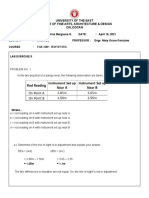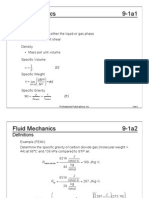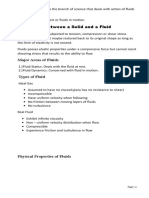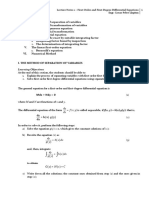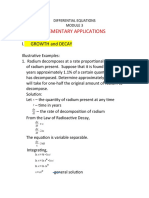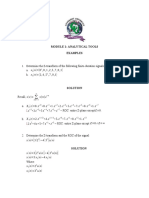Professional Documents
Culture Documents
Equations of Order One: Differential Equations Module 2A
Equations of Order One: Differential Equations Module 2A
Uploaded by
Juvilee RicoOriginal Description:
Original Title
Copyright
Available Formats
Share this document
Did you find this document useful?
Is this content inappropriate?
Report this DocumentCopyright:
Available Formats
Equations of Order One: Differential Equations Module 2A
Equations of Order One: Differential Equations Module 2A
Uploaded by
Juvilee RicoCopyright:
Available Formats
DIFFERENTIAL EQUATIONS
MODULE 2a
EQUATIONS OF ORDER ONE
SOLUTIONS OF DIFFERENTIAL EQUATIONS
A solution to a differential equation is an equation, free of derivatives,
that satisfies the given differential equation.
Example: Show that y=x 2 +cx is a solution of the differential
equation x y ' =x 2 + y
Solution:
y=x 2 +cx y ' =2 x+ c
If this is the solution, then it must satisfy the given differential
equation. Substituting into the given differential equation, we
have
x ( 2 x +c )=x 2+(x 2 +cx )
2 x2 + cx=2 x 2 +cx
Therefore the equation is satisfied.
Kinds of Solutions to Differential Equations
1. General solution – a solution which contains a number of
independent arbitrary constants equal to the order of the
differential equation.
2. Particular solution – a solution which can be obtained from the
general solution by giving specific values to one or more of
the constants.
First Order Equations
dy
Explicit form: dx = F ( x , y )
Implicit form: M ( x , y ) dx+ N ( x , y ) dy=o
I. Equations that are VARIABLE SEPARABLE
A first-order differential equation that is either of the
explicit or implicit form, is variable separable if, by algebraic
manipulation, it can be transformed into the form
A ( x ) dx + B ( y ) dy=0
The solution can then be obtained by integrating each term
of the above equation.
Illustrative Examples:
1. Solve the equation sin x sin ydx +cos x cos ydy=0.
Solution:
Divide both sides of the equation by sin y cos x .
sin x cos y
dx + dy ¿ 0
cos x sin y
Integrating each term of the equation, we get
−lncos x + lnsin y =ln c
ln sin y=ln c+ ln cos x
ln sin y=ln c cos x
sin y=c cos x Ans.
2
2. Solve the equation xy 3 dx+ e x dy =0.
Solution:
2
Divide both sides of the equation by y3 ex ,
x dy
x dx +¿ ¿0
2
e y3
2
x e−x dx + y −3 dy =0
−1 − x y−2 c
2
2 e +¿ −2 −2
=
2
e− x + y −2=c Ans.
3. Solve the equation
( xy + x ) dx=( x 2 y 2 + x 2+ y 2+1 ) dy
Solution:
x ( y +1 ) dx=¿
x ( y +1 ) dx=¿
x ( y +1 ) dx=( x 2 +1 ) ( y 2 +1 ) dy
Divide both sides of the equation by
2
( y +1 ) ( x +1 ). Hence, we get
x y 2+1
2 dx = dy
x +1 y +1
Integrating each term of the above equation,
∫ x x+1 dx=∫( y−1+ y+2 1 ) dy
2
1 y2
ln ( x 2 +1 )= − y +2 ln ( y +1 )+ 2 ln c
2 2
1 y2
ln ( x 2 +1 )= − y +2 ¿
2 2
1 y2
ln ( x 2 +1 )= − y +2 ln c ( y +1 )
2 2
ln ( x 2 +1 )= y 2−2 y + 4 ln c ( y +1 ) Ans.
4. αdβ + βdα +αβ ( 3 dα + dβ ) =0
Solution:
First we distribute the terms.
αdβ + βdα +3 αβ dα + αβdβ=0
β (1+3 α ) dα +α (1+ β ) dβ=0
Dividing both sides by αβ , we get
1+ 3 α 1+ β
dα +¿ dβ=0
α β
∫ 1α +3 dα +∫ 1β + 1 dβ=0
( ) ( )
ln α +3 α + ln β + β +ln c=0
ln cαβ=−3 α −β or cαβ =e−3 α −β Ans.
5. ( 2 a2−r 2 ) dr=r 3 sin θdθ, when θ=0 , r=a .
Solution:
3
Dividing both sides by r , we get
2 a2−r 2
dr =sin θdθ
r3
dr
2 a2∫ r−3 dr−∫ =∫ sin θdθ
r
−2
r
2 a2 −ln r =−cos θ−c
−2
a2
r2
+ lnr =cos θ+ c general solution
When θ=0 , r=a,
a2
+ ln a=cos 0+c
a2
1+ln a=1+c c=ln a
a2
+ lnr =cos θ+ ln a
r2
a2
+ lnr −ln a=cos θ
r2
a2 r
r 2
+ ln =cos θ
a Ans.
2
6. y ' =x e y− x ,
when x=0 , y=0
Solution:
dy
=
2
dx x e y e−x
2
dy =x e y e−x dx
Dividing both sides by e , y
dy
=
2
x e−x dx
ey
2
∫ e− y dy =∫ x e− x dx
−1 − x 1 2
−e− y =¿ e − c
2 2
2
2 e− y =e− x + c general solution
When x=0 , y=0
2 e−0=e−0 +c
2=1+ c c=1
2
2 e− y =e− x +1 Ans.
You might also like
- Cien 30064 HydraulicsDocument83 pagesCien 30064 Hydraulicscalebjohnf0512No ratings yet
- RCE1 SolutionsDocument8 pagesRCE1 SolutionsApril Bacaser DancilNo ratings yet
- Inter 1st Year Maths IA-Functions Study Material PDFDocument29 pagesInter 1st Year Maths IA-Functions Study Material PDFHanuma Reddy71% (7)
- Building Blocks Learning TrajectoriesDocument16 pagesBuilding Blocks Learning TrajectoriesMega NPNo ratings yet
- Rigid Body 3DDocument6 pagesRigid Body 3DSyed ShaulNo ratings yet
- CE Review Advanced MathematicsDocument2 pagesCE Review Advanced MathematicsRAYNo ratings yet
- Axial DeformationDocument46 pagesAxial DeformationSyarif MuhammadNo ratings yet
- Progressions: AP, HP, GP, and Infinite GPDocument36 pagesProgressions: AP, HP, GP, and Infinite GPClark SibiNo ratings yet
- Integral Calculus 3 - PPTXDocument15 pagesIntegral Calculus 3 - PPTXJustine Ejay MoscosaNo ratings yet
- ERIC Compostion of Soil G3Document21 pagesERIC Compostion of Soil G3Alran Eric CifraNo ratings yet
- 4 PrintDocument8 pages4 PrintsubyNo ratings yet
- ES 3A CH 4 Moving LoadsDocument2 pagesES 3A CH 4 Moving LoadsAllenNo ratings yet
- 113Document10 pages113Memo LyNo ratings yet
- Errors in Measurements and Its Propogation PDFDocument19 pagesErrors in Measurements and Its Propogation PDFPiyush GuptaNo ratings yet
- Chapter 3b - Analysis of Tension MembersDocument56 pagesChapter 3b - Analysis of Tension MembersRami DemachkiNo ratings yet
- Cee 109 - First ExamDocument43 pagesCee 109 - First ExamRonald Renon QuiranteNo ratings yet
- Session 3 Kinetics of Particles Work Energy PrincipleDocument34 pagesSession 3 Kinetics of Particles Work Energy PrincipleRosina AdhikariNo ratings yet
- U 1.2 D+1.6 L+0.5 (LR R) : Section 405: Loads Table 405.3.1 Load CombinationsDocument4 pagesU 1.2 D+1.6 L+0.5 (LR R) : Section 405: Loads Table 405.3.1 Load CombinationsMary Joy DelgadoNo ratings yet
- Hydro HyrdoDocument16 pagesHydro HyrdoCherie Gold AccuhNo ratings yet
- CENGR 3140:: Numerical Solutions To Ce ProblemsDocument21 pagesCENGR 3140:: Numerical Solutions To Ce ProblemsBry RamosNo ratings yet
- Energy and HeadDocument9 pagesEnergy and Headdritz tevesNo ratings yet
- Assignment TemplateDocument3 pagesAssignment TemplateAina Margauxe JacintoNo ratings yet
- Buoyancy and Stability of Floating BodiesDocument12 pagesBuoyancy and Stability of Floating BodiesJoe NjoreNo ratings yet
- Volume 1Document15 pagesVolume 1Bhong LucenecioNo ratings yet
- Design of Flexible and Rigid PavementDocument29 pagesDesign of Flexible and Rigid Pavementrodge macaraegNo ratings yet
- Problem 7. Structural Design "CE Board Exam Nov. 1992Document1 pageProblem 7. Structural Design "CE Board Exam Nov. 1992AlvinNo ratings yet
- English Units SI UnitsDocument4 pagesEnglish Units SI UnitsChristian Jay GamboaNo ratings yet
- Statics of Rigid BodiesDocument19 pagesStatics of Rigid BodiesRichelle Valerie BastroNo ratings yet
- CE 2016 Fluid MechanicsDocument26 pagesCE 2016 Fluid MechanicsKyaw Zin HeinNo ratings yet
- Prismoidal Formula 2Document11 pagesPrismoidal Formula 2anggaxkusumaNo ratings yet
- Module 4 Shear and Moment Diagram Part 2Document30 pagesModule 4 Shear and Moment Diagram Part 2FLORENCE BANIAGANo ratings yet
- Analytical Method of Plotting ContoursDocument25 pagesAnalytical Method of Plotting ContoursJan ChristineNo ratings yet
- N 0 T 0 M I M and Iare Taken With Respect To A CentroidalDocument6 pagesN 0 T 0 M I M and Iare Taken With Respect To A CentroidalRetro GamerNo ratings yet
- Sample Math009 PDFDocument2 pagesSample Math009 PDFJohn BernalteNo ratings yet
- Fluid Mech SlidesDocument48 pagesFluid Mech Slidesvinoja29No ratings yet
- Hydraulics - Written ReportDocument7 pagesHydraulics - Written ReportChristian ConsignaNo ratings yet
- Cee 117 Sim SDL CompleteDocument234 pagesCee 117 Sim SDL CompleteRyan DelicaNo ratings yet
- Project Construction Management: Data SheetDocument8 pagesProject Construction Management: Data SheetyfcbrandonNo ratings yet
- Experiment No. 2 Familiarization of Hydraulic Bench ApparatusDocument5 pagesExperiment No. 2 Familiarization of Hydraulic Bench ApparatusMr. Mark B.No ratings yet
- Probset 2Document11 pagesProbset 2Maica Joyce C. MonsalesNo ratings yet
- Fluids MechanicsModule FinalizeDocument86 pagesFluids MechanicsModule FinalizeRitsu TainakaNo ratings yet
- Mathalino: Yes, Numerade Has The AnswersDocument5 pagesMathalino: Yes, Numerade Has The AnswersShiela GonzalesNo ratings yet
- Quiz 2 Ernielle Rae Dela Cruz BSCE-4ADocument9 pagesQuiz 2 Ernielle Rae Dela Cruz BSCE-4AErnielle Rae Dela CruzNo ratings yet
- Volume of RevolutionDocument8 pagesVolume of RevolutionJhoe TangoNo ratings yet
- Cengr 520 - Steel Design & Cengr3220 - Timber & Steel Design - 03192021 - 1Document9 pagesCengr 520 - Steel Design & Cengr3220 - Timber & Steel Design - 03192021 - 1Benjamin EngelNo ratings yet
- BldgElectSystems - AddlexamplesDocument11 pagesBldgElectSystems - AddlexamplesChristian AldeNo ratings yet
- CEHR0313-Mod2 3 2Document27 pagesCEHR0313-Mod2 3 2Kei KagayakiNo ratings yet
- Eng Econ Im 2 PDFDocument13 pagesEng Econ Im 2 PDFSkyNo ratings yet
- Slope and Deflection of Beams Area-Moment Method Theorem 1: The Change in Slope Between Tangents Drawn ToDocument2 pagesSlope and Deflection of Beams Area-Moment Method Theorem 1: The Change in Slope Between Tangents Drawn ToJuDeNo ratings yet
- Fluid MechanicsDocument64 pagesFluid MechanicsCiutac Ionut CristianNo ratings yet
- HAU Teaching DemoDocument15 pagesHAU Teaching DemoRonwell De LeonNo ratings yet
- Beam StressesDocument2 pagesBeam StressesHarsh RanaNo ratings yet
- Quiz 1 - P3 - SolutionDocument6 pagesQuiz 1 - P3 - SolutionJohn Saniel J. EstacionNo ratings yet
- 4-Flexural Members or Beams PDFDocument39 pages4-Flexural Members or Beams PDFKellen Brumbaugh100% (1)
- Ce ReferenceDocument1 pageCe ReferenceOwen Francis Arles MaongatNo ratings yet
- Secondary Consolidation Settlement Part 2 - AGUILOR (PPT Used)Document16 pagesSecondary Consolidation Settlement Part 2 - AGUILOR (PPT Used)Kyohai RinggoNo ratings yet
- Lecture 3 - Kinetics of Particles Energy and Momentum MethodsDocument32 pagesLecture 3 - Kinetics of Particles Energy and Momentum MethodsKeu JiannRong0% (2)
- Lecture Notes 2 - Differential Equations 2020Document41 pagesLecture Notes 2 - Differential Equations 2020Alucard FighterNo ratings yet
- Chapter-2-Separation-of-Variables-ModuleDocument6 pagesChapter-2-Separation-of-Variables-ModuleMARK JAMES PUTOLANNo ratings yet
- Exact Differential EquationsDocument7 pagesExact Differential Equationsفاطمة الرويليNo ratings yet
- Mathematics 1St First Order Linear Differential Equations 2Nd Second Order Linear Differential Equations Laplace Fourier Bessel MathematicsFrom EverandMathematics 1St First Order Linear Differential Equations 2Nd Second Order Linear Differential Equations Laplace Fourier Bessel MathematicsNo ratings yet
- Creativity in Eng'g Drafting and DesignDocument10 pagesCreativity in Eng'g Drafting and DesignJuvilee RicoNo ratings yet
- Elementary Applications: I. Growth and DecayDocument5 pagesElementary Applications: I. Growth and DecayJuvilee RicoNo ratings yet
- Creativity in Eng'g Drafting and DesignDocument8 pagesCreativity in Eng'g Drafting and DesignJuvilee RicoNo ratings yet
- Final Examination Lab: Maximum Power TransferDocument12 pagesFinal Examination Lab: Maximum Power TransferJuvilee RicoNo ratings yet
- Group 3 Experiment 7 SuperpositionDocument14 pagesGroup 3 Experiment 7 SuperpositionJuvilee RicoNo ratings yet
- Exp7 Group - 2Document18 pagesExp7 Group - 2Juvilee RicoNo ratings yet
- Expt 8 - CKT1 - TheveninsDocument4 pagesExpt 8 - CKT1 - TheveninsJuvilee RicoNo ratings yet
- ESC002 - Activity 5Document9 pagesESC002 - Activity 5Juvilee RicoNo ratings yet
- Module 4 - ExamplesDocument18 pagesModule 4 - ExamplesUchechi Chioma UgoNo ratings yet
- Year Seven Mathematics End of Term One 2023Document13 pagesYear Seven Mathematics End of Term One 2023MOHAMED GEREZANo ratings yet
- Classical Electrodynamics - A Tutorial On Its FoundationsDocument21 pagesClassical Electrodynamics - A Tutorial On Its FoundationsPCB SEJ MACENo ratings yet
- Linear Programming-Solving LPP byDocument31 pagesLinear Programming-Solving LPP byAgatNo ratings yet
- Lines and AnglesDocument9 pagesLines and AnglesMahesh k KNo ratings yet
- Monte Carlo Methods in Finance PDFDocument75 pagesMonte Carlo Methods in Finance PDFHasan SamiNo ratings yet
- TocDocument2 pagesTocJagan NathanNo ratings yet
- Linear Equation: QA - BasicsDocument4 pagesLinear Equation: QA - BasicsMana GargiNo ratings yet
- Du MSC Mathematics 2019 Entrance ExamDocument14 pagesDu MSC Mathematics 2019 Entrance ExamVibhu VikramadityaNo ratings yet
- Understanding Cryptography CHPTR 8 - Discrete LogarithmDocument19 pagesUnderstanding Cryptography CHPTR 8 - Discrete LogarithmMahmoud SaidNo ratings yet
- 06 Differential EquationDocument16 pages06 Differential EquationGeeta MNo ratings yet
- Mathematics: Whole Brain Learning System Outcome-Based EducationDocument25 pagesMathematics: Whole Brain Learning System Outcome-Based EducationRachel Yam 3nidadNo ratings yet
- Algebra1-HS-V2-Workbook Algebre 1Document85 pagesAlgebra1-HS-V2-Workbook Algebre 1Julie Bergeron-AllardNo ratings yet
- Machine Learning With Large Networks of People and PlacesDocument47 pagesMachine Learning With Large Networks of People and PlacesfoursquareHQ100% (3)
- Practice Questions Class - X Session - 2021-22 Term 1 Subject-Mathematics (Standard) 041Document19 pagesPractice Questions Class - X Session - 2021-22 Term 1 Subject-Mathematics (Standard) 041Lakshay goyalNo ratings yet
- The Hyper Geometric DistributionDocument79 pagesThe Hyper Geometric DistributionZhiqiang XuNo ratings yet
- 1.GATE 2019 Guide Computer Scienc - GK PUB-2020Document1,065 pages1.GATE 2019 Guide Computer Scienc - GK PUB-2020Prachi GuptaNo ratings yet
- Moksh 21B-1Document106 pagesMoksh 21B-1manjilasinghaNo ratings yet
- Business Statistics MCQsDocument24 pagesBusiness Statistics MCQsBebarg100% (2)
- A Simple PID Controller With Adaptive Parameter in A DsPICDocument5 pagesA Simple PID Controller With Adaptive Parameter in A DsPICAlfian Apin Ma'arifNo ratings yet
- Classical Dynamics: Example Sheet 3: A Ab B ADocument3 pagesClassical Dynamics: Example Sheet 3: A Ab B A김승수No ratings yet
- OMOSpring18Probs PDFDocument7 pagesOMOSpring18Probs PDFJason WangNo ratings yet
- Holiday Homework Class 9Document3 pagesHoliday Homework Class 9umadevimadasamy1983No ratings yet
- Structural ANalysisDocument291 pagesStructural ANalysispairilioNo ratings yet
- Duke Math 122 Problem Set 10Document2 pagesDuke Math 122 Problem Set 10Luke MeredithNo ratings yet
- Math10 WHLP 3rd Quarter Week 1 1Document4 pagesMath10 WHLP 3rd Quarter Week 1 1Mark SolivaNo ratings yet
- Simplification Class NotesDocument4 pagesSimplification Class NotesAngel PriyaNo ratings yet





















